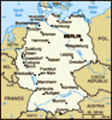German Economy, Germany Economy
Advertisement
Economy - overview: Germany's affluent and technologically powerful economy - the fifth largest in the world - has become one of the slowest growing economies in the euro zone. A quick turnaround is not in the offing in the foreseeable future. Growth in 2001-03 fell short of 1%, rising to 1.7% in 2004. The modernization and integration of the eastern German economy continues to be a costly long-term process, with annual transfers from west to east amounting to roughly $70 billion. Germany's aging population, combined with high unemployment, has pushed social security outlays to a level exceeding contributions from workers. Structural rigidities in the labor market - including strict regulations on laying off workers and the setting of wages on a national basis - have made unemployment a chronic problem. Corporate restructuring and growing capital markets are setting the foundations that could allow Germany to meet the long-term challenges of European economic integration and globalization, particularly if labor market rigidities are further addressed. In the short run, however, the fall in government revenues and the rise in expenditures have raised the deficit above the EU's 3% debt limit.
GDP: 1.5% (2003)
GDP - real growth rate: 1.7% (2004 est.)
GDP - per capita: Purchasing power parity - $28,700 (2004 est.)
GDP - composition by sector: Agriculture: 1% industry: 31% services: 68% (2002 est.)
Population below poverty line: NA
Household income or consumption by percentage share: Lowest 10%: 3.6% highest 10%: 25.1% (1997)
Distribution of family income - Gini index: 30 (1994)
Inflation rate (consumer prices):
Labor force: 42.63 million (2004 est.)
Labor force - by occupation: Agriculture 2.8%, industry 33.4%, services 63.8% (1999)
Unemployment rate: 10.6% (2004 est.)
Budget: Revenues: $1.2 trillion expenditures: $1.3 trillion, including capital expenditures of NA (2004 est.)
Industries: Among the world's largest and most technologically advanced producers of iron, steel, coal, cement, chemicals, machinery, vehicles, machine tools, electronics, food and beverages; shipbuilding; textiles
Industrial production growth rate: 2.2% (2004 est.)
Electricity - production: 560 billion kWh (2003)
Electricity - production by source:
Electricity - consumption: 519.5 billion kWh (2003)
Electricity - exports: 53.8 billion kWh (2003)
Electricity - imports: 45.8 billion kWh (2003)
Oil - production: 74,100 bbl/day (2003)
Oil - consumption: 2.891 million bbl/day (2003)
Oil - exports: 12,990 bbl/day (2003)
Oil - imports: 2.135 million bbl/day (2003)
Oil - proved reserves: 395.8 million bbl (1 January 2004)
Natural gas - production: 21 billion cu m (2003)
Natural gas - consumption: 99.55 billion cu m (2003)
Natural gas - exports: 7.731 billion cu m (2003)
Natural gas - imports: 85.02 billion cu m (2003)
Natural gas - proved reserves: 293 billion cu m (1 January 2004)
Agriculture - products: Potatoes, wheat, barley, sugar beets, fruit, cabbages; cattle, pigs, poultry
Exports: $893.3 billion f.o.b. (2004 est.)
Exports - commodities: Machinery, vehicles, chemicals, metals and manufactures, foodstuffs, textiles
Exports - partners: France 10.3%, US 8.8%, UK 8.3%, Italy 7.2%, Netherlands 6.2%, Belgium 5.6%, Austria 5.4%, Spain 5% (2004)
Imports: $716.7 billion f.o.b. (2004 est.)
Imports - commodities: Machinery, vehicles, chemicals, foodstuffs, textiles, metals
Imports - partners: France 9%, Netherlands 8.3%, US 7%, Italy 6.1%, UK 5.9%, China 5.6%, Belgium 4.9%, Austria 4.2% (2004)
Debt - external: NA
Economic aid - recipient:
Currency:
Currency code:
Exchange rates: Euros per US dollar - 0.8054 (2004), 0.886 (2003), 1.0626 (2002), 1.1175 (2001), 1.0854 (2000)
Fiscal year: Calendar year
Advertisement
The information here has been derived from Public Domain Sources such as the CIA World Factbook. No liability can be taken for any inaccuracies.
Tot: 0.037s; Tpl: 0.008s; cc: 3; qc: 2; dbt: 0.0066s; 1; m:domysql w:travelblog (10.17.0.13); sld: 1;
; mem: 1.1mb

 As Europe's largest economy and most populous nation, Germany remains a key member of the continent's economic, political, and defense organizations. European power struggles immersed Germany in two devastating World Wars in the first half of the 20t...
As Europe's largest economy and most populous nation, Germany remains a key member of the continent's economic, political, and defense organizations. European power struggles immersed Germany in two devastating World Wars in the first half of the 20t...
